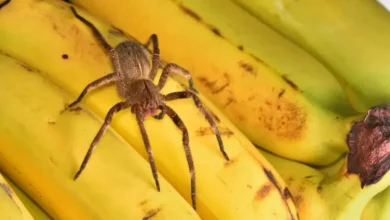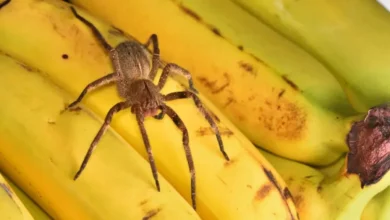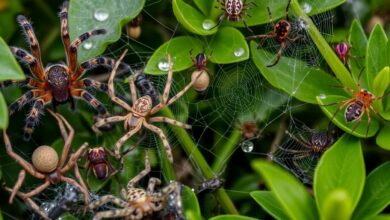Top 5 Biggest Spiders in the World
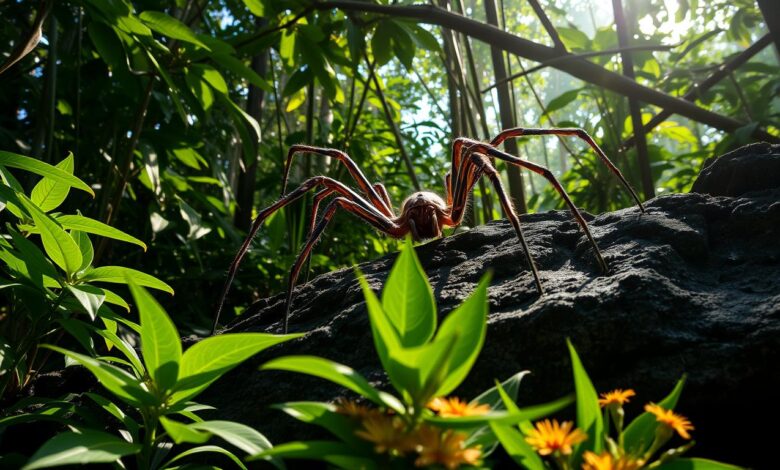
The world is home to some truly magnificent spiders. A few species stand out as the largest. From the colossal Goliath birdeater of South America to the enigmatic Venezuelan giants, these arachnid titans captivate the imagination.
Get ready to be amazed as we unveil the top 5 biggest spiders on Earth. We’ll explore fascinating facts about their habitats, behaviors, and physical characteristics. Discover how these impressive arthropods impact their ecosystems and learn about the ongoing efforts to conserve these natural wonders.
The Goliath Birdeater: Theraphosidae Behemoth
Get ready to be amazed by the Goliath birdeater, the world’s largest spider. They belong to the Theraphosidae family. These huge spiders can have a leg span of up to 12 inches and weigh over 6 ounces. They are true giants among spiders.
Habitat and Behavior
The Goliath birdeater lives in the lush rainforests of northern South America. This includes Venezuela, Guyana, and Brazil. They are nocturnal and use ambush tactics to catch small mammals, frogs, and birds.
With their strong fangs, they can easily overpower their prey.
Physical Characteristics
The Goliath birdeater is huge and has a fearsome look. Their body is as big as a human hand, and their legs are thick and hairy. Their fangs can be up to 1.5 inches long, which can hurt but isn’t deadly.
They also have special hairs on their abdomen. These hairs can be rubbed together to make a hissing sound. This is a warning to any threats.
| Characteristic | Measurement |
|---|---|
| Leg Span | Up to 12 inches (30 cm) |
| Body Length | Up to 4 inches (10 cm) |
| Weight | Up to 6 ounces (170 g) |
| Lifespan | Around 10 years |
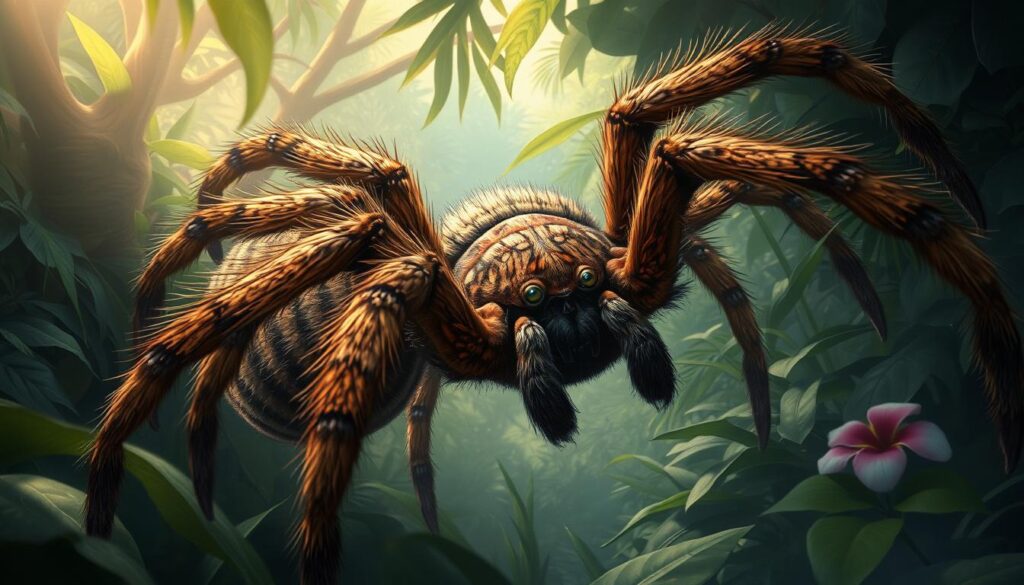
The Goliath birdeater spiders are truly awe-inspiring. Their size, physical features, and behaviors make them fascinating creatures.
Venezuelan Spiders: Arachnid Giants
Venezuela is home to many massive spiders, besides the Goliath birdeater. The Venezuelan Pinkfoot Goliath, Theraphosa apophysis, is almost as big. The Venezuelan Suntiger, Psalmopoeus irminia, stands out with its bright colors and long legs. These spiders are key players in Venezuela’s ecosystems.
The Venezuelan Pinkfoot Goliath is one of the biggest tarantulas. It can have a leg span of up to 12 inches and a body of 5 inches. Its pink feet and strong jaws help it catch prey like small rodents and birds.
The Venezuelan Suntiger is another impressive spider. It can grow up to 8 inches wide. It’s known for its amber-colored shell and long legs. Nature lovers and photographers often focus on this spider because of its beauty and behavior.
| Spider Species | Maximum Leg Span | Body Length | Distinctive Features |
|---|---|---|---|
| Venezuelan Pinkfoot Goliath | 12 inches (30 cm) | 5 inches (12 cm) | Pink-tinted feet, powerful jaws |
| Venezuelan Suntiger | 8 inches (20 cm) | N/A | Rich, amber-colored carapace, slender legs |
These spiders, including the Goliath birdeater, show the amazing variety of arachnids in Venezuela. They are important in their ecosystems, helping to keep everything in balance.
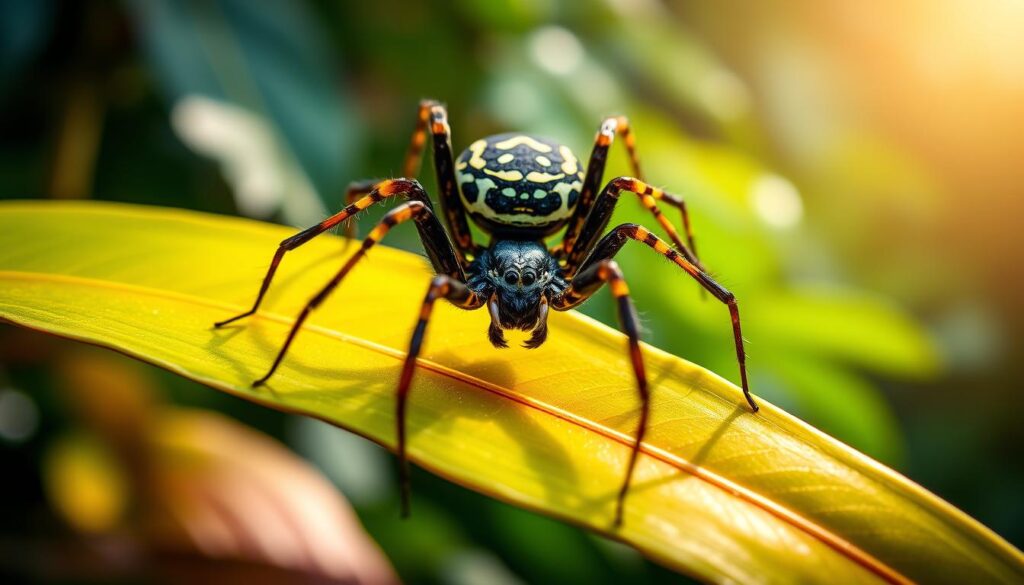
 Discover Fascinating Types of Spiders in Your World
Discover Fascinating Types of Spiders in Your World
world largest spider: Guinness World Records
The title of “world’s largest spider” is highly sought after. Many species compete for the Guinness World Record. The Goliath birdeater is known for its massive size. But, the Giant Huntsman spider, Heteropoda maxima, has the largest leg span, reaching up to 1 foot (30 cm) across.
Other contenders include the Brazilian Salmon Pink Birdeater and the Vietnamese Cent-eyed spider. These spiders are truly impressive. They show the amazing diversity and size of spiders, fascinating both scientists and the public.
Contenders for the Crown
- Giant Huntsman Spider (Heteropoda maxima): This spider has the largest leg span, reaching up to 1 foot (30 cm) across.
- Brazilian Salmon Pink Birdeater: Known for its size and striking appearance, it’s a strong contender.
- Vietnamese Cent-eyed Spider: Another giant spider competing for the title of world’s largest.
These spiders are truly amazing, showing the incredible diversity and size of spiders. The competition for the Guinness World Record is ongoing. Researchers and enthusiasts are working hard to find out who is the true largest spider.
Macro Photography: Capturing Arthropod Majesty
In macro photography, the biggest spiders are a big hit. These artists use special gear to show off the tiny details of these huge arachnids. Their work brings out the alien-like beauty of these creatures, making us all amazed.
Photographers have captured the majesty of spiders like the Goliath Birdeater and the Venezuelan Giant. They use special lighting and framing to show us a world we can’t see normally. It’s like looking at a different universe.
The photos are more than just pictures; they’re art that makes us slow down and look closely. We see the tiny hairs, patterns, and movements of these spiders. It’s like seeing a miracle.
Macro photography turns tarantulas from scary to stunning. It shows off their colors and textures in a way that makes us love them. These artists help us see the natural world in a new light.
Exploring macro photography, we find beauty everywhere. Even the biggest spiders are now seen as amazing subjects for art. They inspire us to appreciate the incredible variety of life on Earth.
Tarantula Titans: Exploring Theraphosa Species
The Theraphosa genus is home to the famous Goliath birdeater. It’s a group of huge tarantulas found mainly in South America’s lush forests. This genus includes many giant spider species, each with its own special traits and ways to live in its habitat.
Diversity Among the Giants
The Burgundy Birdeater and the Salmon Pink Birdeater are two standout examples in the Theraphosa genus. The Burgundy Birdeater has a deep burgundy color and can grow up to 11 inches wide. The Salmon Pink Birdeater, on the other hand, has a bright pink color and can grow up to 10 inches wide.
These giant spiders have evolved to live well in their environments. Each species has its own role in its ecosystem. The Theraphosa genus shows how diverse and adaptable tarantulas and theraphosa species can be.
| Species | Average Leg Span | Distinguishing Features |
|---|---|---|
| Goliath Birdeater | Up to 12 inches (30 cm) | Largest known living spider |
| Burgundy Birdeater | Up to 11 inches (28 cm) | Deep burgundy coloration |
| Salmon Pink Birdeater | Up to 10 inches (25 cm) | Vibrant pink coloration |
Impact on Ecosystems: Roles of Mega Arachnids
The world’s largest spiders, known as mega arachnids, may look scary. But they are vital to the ecosystems they live in. They are top predators, keeping the food web balanced by controlling smaller animals and insects.
Their burrows and nests are homes for many other species. This shows how important mega arachnids are for their ecosystems.
But, human actions can upset this balance. We need to protect these amazing creatures. By learning about their roles in ecosystems, we can help save them for future generations.
 Discover Spiders in Arizona: Your Ultimate Guide
Discover Spiders in Arizona: Your Ultimate Guide
Mega arachnids help control pests and offer shelter and resources. Saving them is key to keeping our natural world balanced and diverse.
Myths and Legends: Cultural Significance
From Folklore to Fact
The world’s largest spiders have always fascinated people. Their huge size and strange looks have sparked myths and legends in many cultures. In some places, these spiders are seen as sacred or symbols. In others, they are feared as monsters.
As we learn more about these spiders, many myths have been proven wrong. We now know the real facts about their biology and behavior.
Spiders like the Goliath Birdeater and the Venezuelan spider giants are seen as cultural significance beyond their size. In old stories, they were often seen as guardians, tricksters, or signs of doom. This shows how complex our relationship with nature is.
Looking into the myths and legends of these spiders, we find a rich world of folklore. These stories show the creativity and ingenuity of different cultures. Some stories come from fear or misunderstanding, but others celebrate the spiders’ strength and importance in their ecosystems.
By understanding the cultural significance of the world’s largest spiders, we appreciate their impact on human imagination. From ancient myths to today’s science, the journey from folklore to fact shows our lasting interest in these amazing creatures.
Conservation Efforts: Protecting the Giants
As more people learn about the world’s largest spiders, the need to protect them grows. Threats like habitat loss, deforestation, and the illegal wildlife trade harm many giant spider species. Conservation groups, researchers, and enthusiasts are working hard to study and protect these spiders. They aim to keep these arachnids safe for future generations.
Preserving their habitats is a key part of spider conservation. The Goliath Birdeater and the Venezuelan Pinktoe Tarantula live in South America’s rainforests. Saving these forests is essential for the spiders’ survival.
Research and monitoring are also crucial. Scientists study the spiders’ habits and threats they face. This knowledge helps in creating effective protection plans and policies.
| Species | Conservation Status | Threats |
|---|---|---|
| Goliath Birdeater | Least Concern | Habitat loss, illegal trade |
| Venezuelan Pinktoe Tarantula | Vulnerable | Habitat loss, deforestation |
| Hercules Beetle | Least Concern | Illegal trade, habitat degradation |
By protecting habitats, researching, and educating the public, we can save the world’s largest spiders. Raising awareness helps ensure these creatures thrive in their natural habitats. This way, we can appreciate their role in our ecosystems.
Ethical Handling: Appreciating from Afar
The world’s largest spiders are truly captivating. However, it’s vital to handle them with great care and respect. Experts warn against trying to handle or capture giant spiders. Their bites and defensive actions can be dangerous.
The best way to enjoy these spiders is to watch them from a distance. You can do this through macro photography, educational exhibits, or in their natural habitats. This way, we can appreciate them without risking harm to ourselves or the spiders.
By choosing to appreciate these spiders responsibly, we help ensure their survival. These giant spiders are crucial to their ecosystems. Their preservation helps keep nature’s balance intact. Through careful observation, we can learn about them without putting them or ourselves in danger.
Seeing the world’s largest spiders in their natural setting is truly awe-inspiring. By watching them from afar, we gain a deeper respect for these incredible creatures. This way, future generations can also marvel at the planet’s most impressive arachnids.
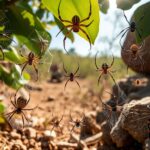 Discover Texas Spiders: Your Guide to Local Arachnids
Discover Texas Spiders: Your Guide to Local Arachnids
